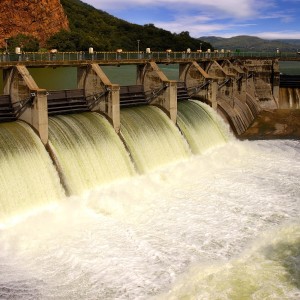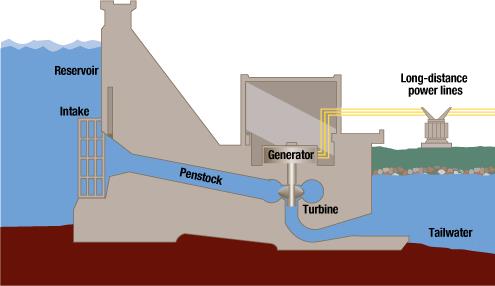
Hydroelectric power uses the kinetic energy of moving water to produce electricity. It's the most widely used form of renewable energy, generating 19% of electricity worldwide (1). While large-scale projects have had mixed results in the developing world, when done properly, hydroelectric is a cheap, clean and effective method of producing energy.
Hydroelectric Methods
Most hydroelectric power plants are located on a river at a high elevation, using a dam to hold back the water in a reservoir. When released, the water flows into the dam through a pipe called a penstock. The force of the falling water pushes a turbine, which turns an electric generator. The steeper the drop, the more power the water has, creating more energy.
Another method is a run-of-the-river diversion, where instead of the water being held back, it's diverted from the river through a penstock to the turbines, and then released back to the river. Hydroelectric power isn't just confined to rivers. Ocean waves, tides and currents are also tapped to provide energy, although current capacity is being utilized on a vastly smaller scale than traditional hydroelectric dams.

(source: Tennessee Valley Authority)
Hydroelectric Capacity
Hydroelectric power generates anywhere from a few kilowatts, good enough to power a few light bulbs, to over 20 gigawatts (GW), enough to power large cities. The largest hydroelectric power stations in the world are the Three Gorges Dam (22 GW) in China, the Itaipu Dam (14 GW) on the border of Brazil and Paraguay, and Guri Dam (10 GW) in Venezuela (2).
Hydroelectric power is also cost-effective, with a national average of 9 cents per kilowatt-hour in the U.S., which compares quite favorably to solar (11 cents / kWh), coal (9 cents / kWh) and natural gas (6 cents / kWh) (3). ,Places with abundant water sources, like the Pacific Northwest, have even cheaper rates. This is one reason why Washington, Oregon and Idaho get more than 50% of their electricity from hydroelectric power, compared to the national average of 6-7% (4). Some countries, like Norway, have enough hydropower resources to generate all or nearly all of their electricity. Worldwide, the top five leaders in hydropower capacity are China, Canada, Brazil, the U.S. and Russia (5).
Pros & Cons of Hydroelectric Power
Once built, hydroelectric plants have very low operation and maintenance costs. A hydropower plant can stay in service for 50-100 years (6). Unlike other forms of renewable energy, hydroelectric has the ability to rapidly scale up to maximum output levels when extra power is needed. It's a very clean form of energy, producing no air or water pollution, and produces small amounts of greenhouse gases (methane released from rotting vegetation submerged under the reservoir).
On the other hand, hydroelectric plants cost hundreds of millions of dollars to build and take many years to complete. Damming a river with a large hydroelectric plant can submerge tens or even hundreds of square miles of land under its reservoir (7), altering the local ecosystem both in the reservoir area and further downstream. Dams can result in loss of habitat and loss of migratory routes for species such as salmon. People can also be affected. Any homes in the reservoir's flood zone will be submerged and the residents forced to relocate. As one example, over a million people were moved during construction of China's Three Gorges Dam (8). And while water is a renewable resource, a hydroelectric plant's output is affected by seasonal variations in water supply.
Future Trends
In the U.S., future construction is limited, as most prime locations for hydroelectric dams have already been utilized. However, the Energy Department reports that of the 80,000 dams in the country, only 3% are used to generate power. Retrofitting those dams with hydroelectric plants could add an additional 12 GW of electricity to the national grid. There is continued research into ways to mitigate the environmental impact of dams. Power from ocean waves could be the next big renewable energy source, with a stunning 1000+ terawatts of potential resources along the U.S. coast alone, according to the Electric Power Research Institute.
Hydroelectric Power Careers
Some 300,000 people work in the U.S. hydroelectric power industry (9). Major fields include research, development, manufacturing, construction, and plant operations. There are many environmental careers available. Environmental engineers are involved in designing the hydroelectric plants. Environmental lawyers advocate for the interests of power companies, local communities and government regulatory agencies during the planning and construction phases. Environmental scientists and ecologists study and help reduce the impact of hydroelectric plants on the local environment.
Sources
(1)
http://water.usgs.gov/edu/wuhy.html
(2)
http://en.wikipedia.org/wiki/Hydroelectricity
(3)
http://www.eia.gov/forecasts/aeo/electricity_generation.cfm
(4)
http://energy.gov/articles/top-10-things-you-didnt-know-about-hydropower
http://energy.gov/eere/water/hydropower-basics
http://www.eia.gov/kids/energy.cfm?page=hydropower_home-basics
(5)
https://www.iea.org/reports/renewable-energy-essentials-hydropower
(6)
http://link.springer.com/article/10.1007%2FBF01867675
https://www.jstor.org/stable/20092990
(7)
http://www.nytimes.com/2007/11/19/world/asia/19dam.html?pagewanted=all&_r=0
http://e360.yale.edu/feature/the_dam_building_boom_right_path_to_clean_energy/2119/
(8)
http://www.hydro.org/why-hydro/job-creation/
- Nuclear Energy 101 - December 1, 2014
- Wind Power 101 - November 30, 2014
- Natural Gas 101: Pros & Cons - October 24, 2014
Related Articles
Featured Article

Cartography: More Than a View From Above





